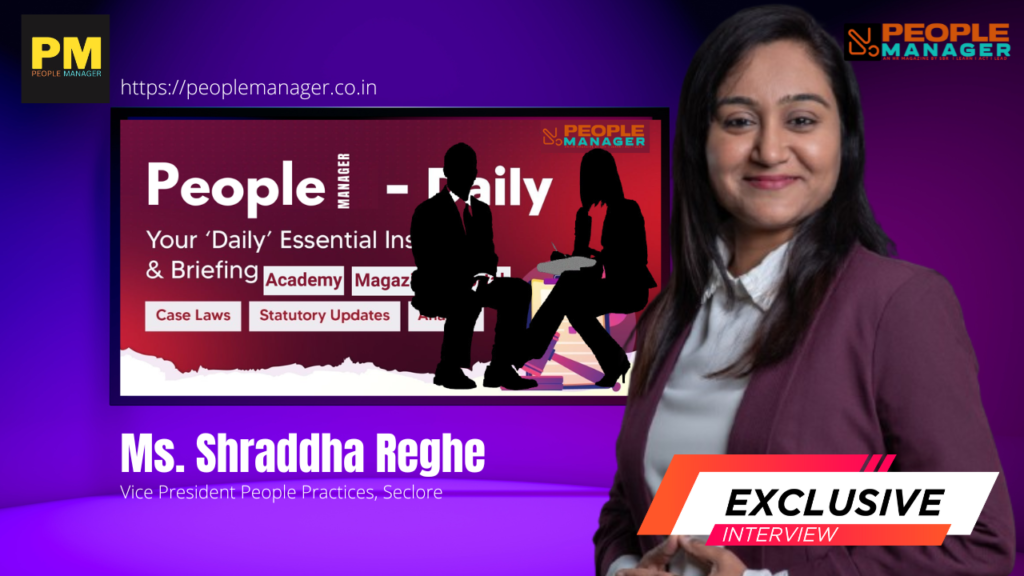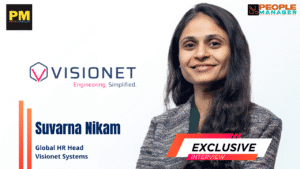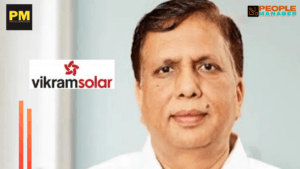Shraddha Reghe on Data Security in HR: Protecting Employee Privacy in a Digital Workplace
In this interview Shraddha Reghe, Vice President of People Practices at Seclore, discussed the critical challenges HR functions faces in ensuring data security in a rapidly evolving digital workplace. Key topics include managing sensitive employee information, addressing the risks posed by remote work, and the importance of employee training in mitigating security breaches. Reghe emphasizes the need for collaboration between HR, IT, and cybersecurity teams to protect employee data and highlights advanced solutions like encryption, multi-factor authentication, and data-centric security. She also outlines best practices for balancing data accessibility with security, staying compliant with regulations like GDPR and CCPA, and preparing for future HR data security trends.

Q. What are the biggest challenges HR functions faces in ensuring data security in a digital workplace?
Ans: In today’s evolving digital workplace, HR leaders face significant data security challenges, such as managing the growing volumes of sensitive employee information, complying with complex regulations, and integrating diverse technologies. The shift to remote work has expanded attack surfaces, making monitoring and protecting data access harder. Human error remains a significant cause of data breaches, highlighting the need for employee awareness of security protocols. Additionally, HR departments handle highly sensitive data like payroll and performance records, making them prime targets for cybercriminals. Addressing these challenges requires proactive strategies and close collaboration with IT and cybersecurity teams to safeguard sensitive employee information. At Seclore, we leverage data-centric security solutions, ensuring data protection , access control, and real-time visibility into data sharing.
Q. How can HR professionals balance the need for data accessibility with the need for data security?
Ans: For HR leaders, achieving the right balance between data accessibility and security is a top priority. HR leaders can effectively balance data accessibility and security by implementing key strategies. Role-Based Access Control (RBAC) ensures employees only access necessary data, while data encryption protects information both at rest and in transit. Multi-Factor Authentication (MFA) adds an extra layer of security, regular audits play a vital role in identifying unnecessary access permissions, making sure data remains protected yet available when needed.Secure HR systems, data minimization practices, and comprehensive employee training further enhance protection. Collaboration with IT and cybersecurity teams is vital to align accessibility with security measures.
The key is to strike a balance between operational efficiency and robust security measures. At our company, we’ve adopted advanced technology solutions that not only safeguard data but also ensure seamless access for HR teams. These solutions allow us to monitor and control data access—determining who can view, use, and share it, even beyond our organization’s boundaries. This way, we empower our HR team with the data they need, ensuring it’s always secure and in the right hands.
Q. What role does employee training play in protecting sensitive HR data, and what best practices would you recommend?
Ans: Employee training is essential for protecting sensitive HR data, equipping staff with the knowledge to understand security protocols and recognize potential threats. Effective programs raise awareness of data security policies, phishing awareness, and proper handling of sensitive information.
Best practices include conducting regular training sessions, integrating data protection into the onboarding process, and using real-world scenarios and simulations to enhance engagement and retention. Ongoing reminders and updates about security protocols keep data protection at the forefront.
At Seclore, we emphasize continuous training that covers everything from recognizing phishing attacks to secure data-sharing protocols. By fostering a culture of vigilance, where employees feel empowered to report suspicious activities, we can significantly strengthen our defenses against data breaches and safeguard sensitive HR information.
Q. Can you emphasis the impact of remote work on HR data security and how companies can mitigate associated risks?
Ans: The transition to remote work has significantly reshaped HR data security, exposing vulnerabilities such as unsecured home networks and personal devices accessing sensitive information. This scenario increases the risk of data breaches and complicates compliance as employees operate from various locations.
To address these challenges, organizations should implement virtual private networks (VPNs) to ensure secure connections and establish strong password protocols. Equipping employees with secure data handling tools and enforcing strict device management policies—requiring the use of company-approved and regularly updated devices—are crucial strategies.
Additionally, conducting regular security assessments and audits of remote access protocols can help uncover potential vulnerabilities. At Seclore, we emphasize secure remote access systems and a zero-trust security model to protect endpoints, ensuring that the shift to remote work does not compromise data integrity. By proactively adopting these measures, businesses can safeguard sensitive HR information while empowering employees to work effectively from any location.
Q. What are the key components of a robust data security policy for HR departments?
Ans: An effective HR data security policy is crucial for protecting sensitive information and should encompass several essential elements. It should start with clear data classification criteria based on sensitivity levels, followed by robust access controls that define role-based permissions. Additionally, encrypting data both at rest and in transit is vital for safeguarding information. Ongoing monitoring and auditing help identify potential breaches, while a well-defined incident response plan provides a roadmap for addressing any data security incidents. Regular training for employees on data protection protocols enhances overall awareness, and ensuring compliance with relevant regulations is key. Emphasizing data minimization and fostering collaboration with IT and cybersecurity teams further strengthens security measures. At Seclore, we continuously enhance these policies with cutting-edge technology and adapt them to meet emerging threats.
Q. How do you ensure compliance with data protection regulations such as GDPR and CCPA in HR practices?
Ans: To achieve compliance with data protection regulations such as GDPR and CCPA in HR practices, organizations should adopt a multi-faceted approach. This begins with identifying and classifying the personal data they collect, ensuring that privacy policies are routinely updated to meet regulatory standards. Implementing effective consent management systems is crucial for capturing and documenting employee consent, while stringent access controls should restrict data access to authorized personnel only. Organizations must also practice data minimization by collecting only the information necessary for their operations and securely disposing of data that is no longer needed. Ongoing employee training on data protection is vital, along with a well-defined incident response plan to address any data breaches promptly. Additionally, companies should ensure that third-party vendors comply with data protection requirements, conduct regular compliance audits, and integrate privacy considerations into their HR processes from the outset. This comprehensive strategy will not only meet regulatory obligations but also promote a culture of privacy and security within the organization.
Q. What technologies or tools do you find most effective in safeguarding employee data?
There are multiple tools availabe in the market, but Seclore relises on a combination of technologies to protect employee data, and these include:
- Use Data Loss Prevention (DLP) tools to monitor and protect sensitive information
- Opt for Encryption solutions for secure data at rest and in motion.
- Access management systems to enforce role-based access controls.
- Security Information and Event Management (SIEM) tools for real-time monitoring and response to security incidents.
Q. How should HR handle data breaches, and what steps should be taken immediately following a breach?
Ans: In the event of a data breach, HR should follow a structured response plan that includes securing affected systems to prevent further exposure, assessing the damage, and determining the breach’s scope. They must alert interested parties, including employees and regulatory agencies, and document evidence for future security efforts. After addressing immediate concerns, it’s crucial to review and update security policies and training based on lessons learned. Engaging forensic experts and providing ongoing support to affected individuals are also important for rebuilding trust and enhancing future data security measures.
Q. Can you share examples of common vulnerabilities in HR data systems and how to address them?
Ans: Some of the common vulnerabilities in HR data systems and ways to address them:
- Weak Password Practices: Mitigate by enforcing strong, complex password policies and using multi-factor authentication.
- Unencrypted Data: Protect sensitive information with encryption, both when it’s stored and during transmission.
- Outdated Software: Regularly update and patch software to prevent exploitation of security gaps.
- Phishing Vulnerabilities: Provide ongoing training to employees on recognizing and avoiding phishing scams.
- Unauthorized Data Access: Implement role-based access controls, ensuring only authorized employees can access sensitive data.
- Infrequent Security Audits: Conduct routine security audits to proactively identify and fix any vulnerabilities.
Q. What future trends do you foresee in HR data security, and how should companies prepare for them?
Ans: The landscape of HR data security is rapidly transforming, with organizations increasingly adopting AI-driven security measures, zero-trust architectures, and biometric authentication to bolster defenses. There is a strong emphasis on enhancing cloud security and implementing advanced encryption techniques to safeguard sensitive information. Companies are also focusing on real-time threat detection and automated incident responses to effectively mitigate breaches. Compliance with data protection regulations is a critical priority, along with proactive risk assessments and strategies to mitigate vendor-related cybersecurity threats. Additionally, firms are leveraging a data-centric approach that ensures continuous monitoring and protection of sensitive data, irrespective of its location. This forward-thinking perspective reflects a shift towards a more proactive and resilient approach to addressing emerging security challenges in HR data management.
Stay tuned, to PeopleManager.co.in for further updates on the evolving workplace paradigm.
- AI in HR: Why ROI Isn’t the Right Question—Yet - September 8, 2025
- The Hidden Cost of Fear in the Workplace: Why Generational Optimism Isn’t Enough - September 2, 2025
- Forced Resignations in India’s IT Sector: A Legal Blind Spot Demanding Urgent Reform - August 19, 2025







